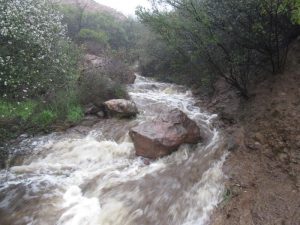Respecting the force of Mother Nature
Commentary: When the rains come
Source of this article: The Thousand Oaks Acorn, January 26, 2017
Risk is a fact of life for outdoors enthusiasts, and smart people know they should always weigh the pros and cons when they venture into the wild.
In Southern California this winter—with an onslaught of powerful rainstorms arriving in rapid succession—residents are reveling in the abundant moisture.
But the running creeks, waterfalls, slick boulders, puddle-filled depressions, eroded slippery trails, rock slides and other hazards related to heavy rains have been absent for so long that it’s time to take a refresher course in confronting a natural world that has come explosively alive.

DANGER—Last week’s mega rainstorm brought flooding to local streets and fast-flowing volume to creeks and waterfalls. The National Weather Service says 5 inches of rain fell in Thousand Oaks last week. During the same period last year, 0.14 inches fell. This torrent, normally a trickle or even completely dry, blocks the Canyon View Trail below Sandstone Peak.
At the height of a storm, a dry stream bed can become a dangerous and unforgiving torrent, its frothing, tumbling water laden with visible debris as well as unseen submerged rocks. The deafening roar of water may thrill us, but it should not blind us to the extreme hazard posed.
Folks angling for a “memorable” photograph need to be aware of how slippery footing can lead to far more than a twisted ankle. Falling into these newly fledged waterfalls and rapids can cause serious injury, including broken bones, hypothermia, head trauma and drowning.
When National Park Service properties as well as community parks post a sign announcing, “Area closed due to wet conditions,” residents should heed, not ignore, the warning.
The signs serve a dual purpose— to protect natural resources and to safeguard the welfare of outdoors lovers. Trails may be compromised if not inundated by runoff, and usage by equestrians, bicyclists and hikers only compounds the damage. Trail users also pose a risk to themselves when they challenge these sodden, unstable conditions
Wildwood Park in Thousand Oaks and Oak Canyon Community Park in Oak Park are among the area parks that have posted closure signs.
The park service wants hikers, bikers and climbers to know that just as “red flag” postings during fire season mean “stay off parkland,” the same is true for wet weather warnings.
During severe weather, be a responsible steward of our local, state and national parks and take a pass on going out.
There will simply never be enough rangers available to patrol all the daredevil-tempting attractions, many of which are located deep in canyon bottoms where creeks flow furiously through a maze of house-size boulders.
Trained swift-water rescue specialists and members of search and rescue teams are among the most heroic individuals, but they can’t be expected to be everywhere at once.
We need to use sense and exercise caution when out in the wet and wild.
Yes, it is undeniably exciting that rain has returned to our parched lives. But rain, and even more rain, is a powerfully transforming force.
When the thirsty earth can no longer absorb moisture, the moisture runs off—not in gentle dribbles but in gushing floodwaters.
Gauge the situation, wait for the worst weather to subside, and even then wait a few days longer before exploring.
Observe from a safe distance, always be aware of your surroundings as well as your footing, and be super diligent in monitoring the children and pet dogs in your party.
Best reminder to tape to your fridge or dashboard: Nature shows no mercy for reckless fools—and winter is not always a wonderland.



0 Comments